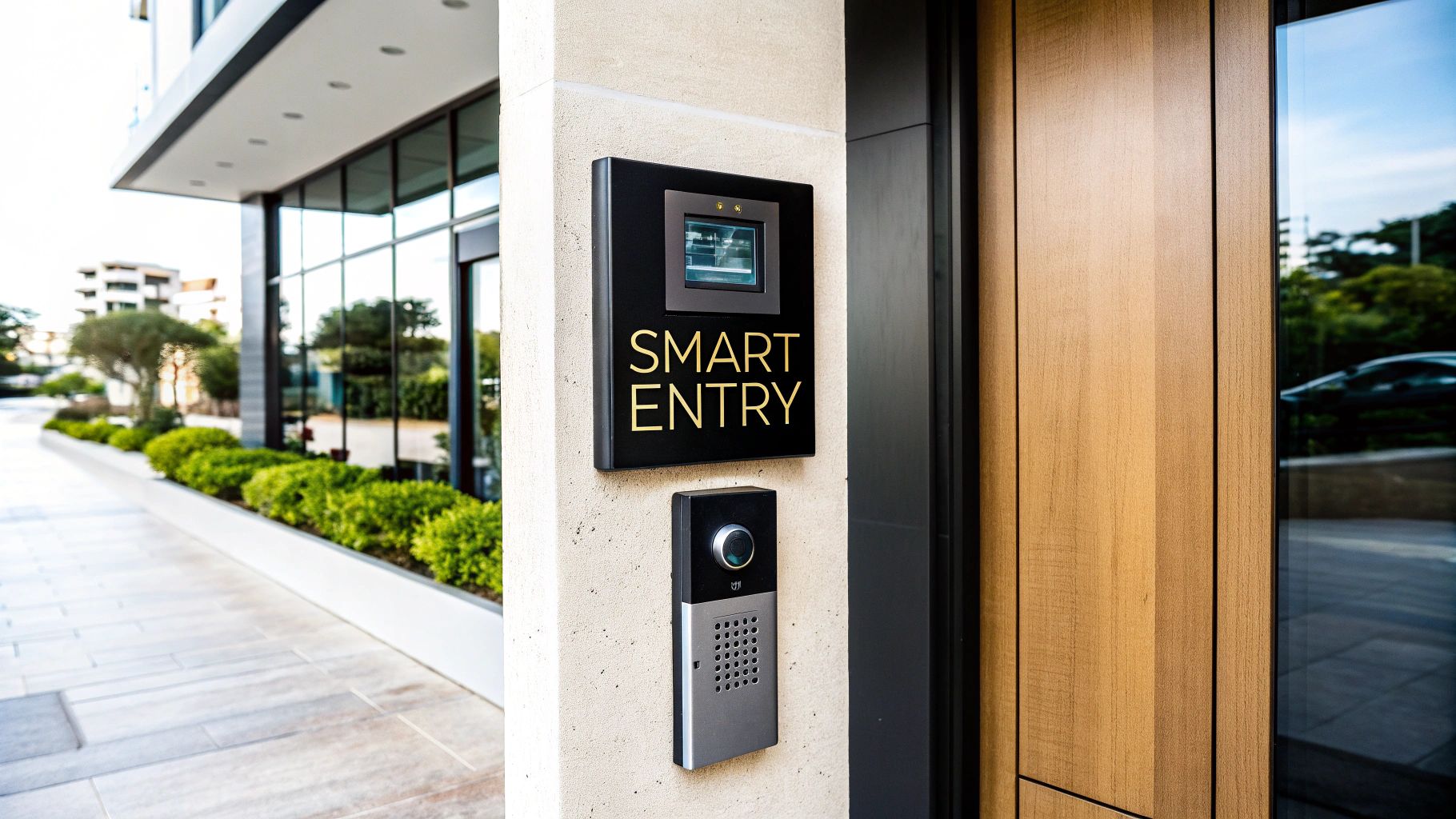When you think of an intercom, you might picture an old-school, crackly speaker box with a single button. That's ancient history. Today’s intercom systems for buildings are more like a smartphone for your front door—a powerful command center that seamlessly manages who comes and goes.
At their heart, they're all about providing a secure, convenient way to screen visitors and control entry. This makes them the true gatekeepers of a property's security setup.
Understanding the Evolution of Building Intercoms
The leap from a simple push-to-talk button to a smart, cloud-connected device signals a huge shift in property technology. Early systems were one-trick ponies: they sent a voice down a wire. Now, modern IP video intercoms can handle video calls, unlock doors from halfway around the world, manage visitor passes, and even link up with other smart building tech.
This change hasn't happened in a vacuum. It’s been driven by our growing need for both top-notch security and everyday convenience, whether in a high-rise apartment building or a busy corporate office. We'll explore how these advanced systems boost safety and make operations smoother for any property manager.
From Audio Buzzers to Smart Networks
Think of intercom technology as a ladder. With each rung, we’ve gained new capabilities that have completely changed how we interact with our buildings. At the bottom rung, you have basic audio systems that let you verify someone's identity by voice. A step up from that, video was added, giving you that crucial visual confirmation.
But the real game-changer was the move to IP (Internet Protocol) systems. By plugging into a building's network, these intercoms opened up a whole new world of possibilities.
- Remote Access: You can grant entry from a mobile app, whether you're in your living room or on vacation.
- Cloud Management: Updating resident lists and access rights is as simple as logging into a web dashboard.
- Integration: They can talk to other security gear, like your CCTV cameras or key card readers.
- Visitor Logs: Every entry event creates a time-stamped photo log, giving you a clear audit trail.
This infographic lays out the evolution perfectly, showing the journey from basic audio to sophisticated IP video technology.
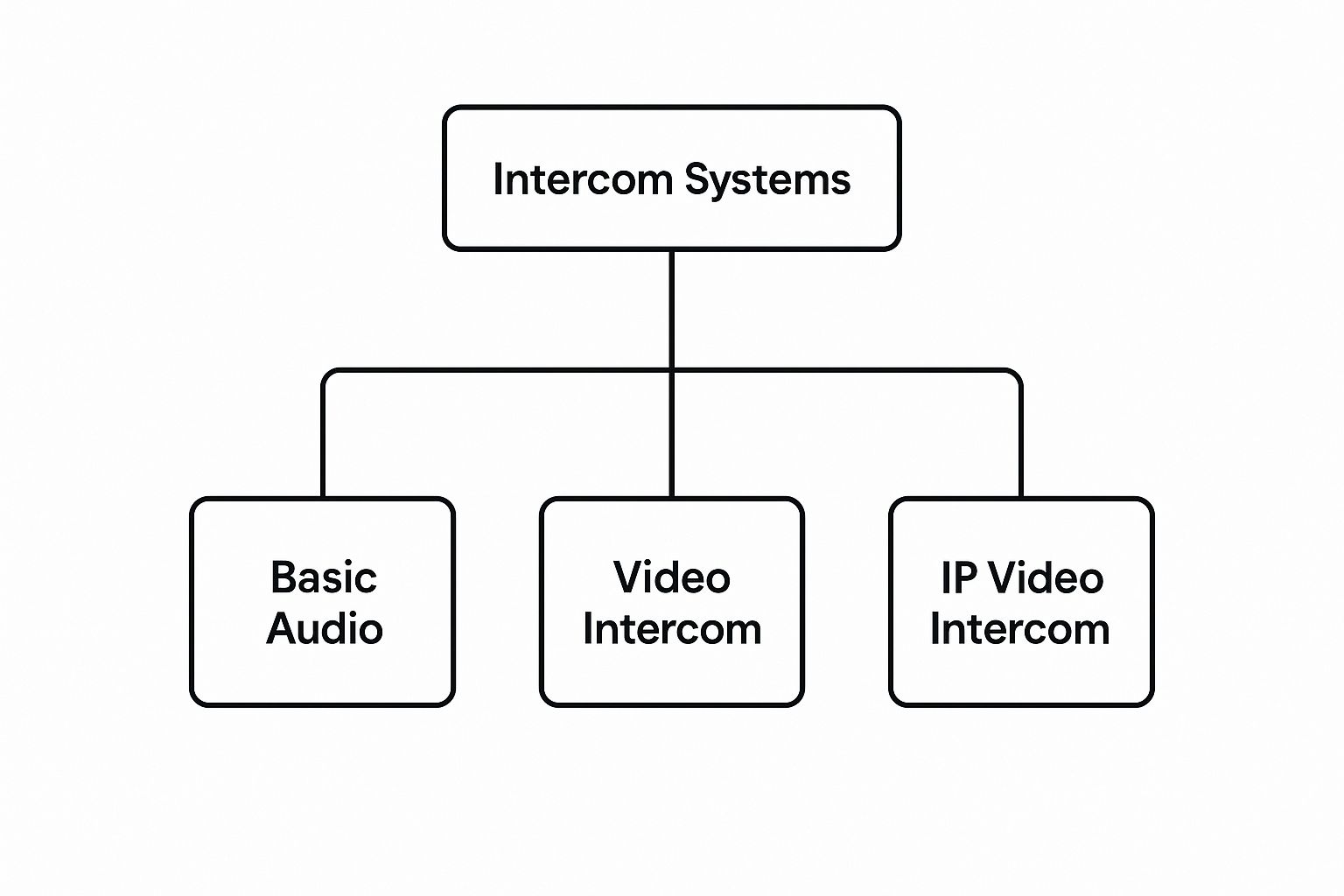
As you can see, each generation stacked new layers of function and intelligence on top of the last.
The Growing Market for Secure Access
This jump in technology isn't just a niche interest; it's fueling massive market growth. In 2024, the intercom systems market was valued at around $23.32 billion, and it’s expected to hit $24.89 billion by 2025. That kind of growth shows just how much demand there is for smarter, more reliable security and communication tools in every kind of building.
At its core, a modern intercom isn't just a communication device; it's the central nervous system for your building's entry points. It connects tenants, managers, and visitors in a secure, manageable ecosystem.
This network-first approach, however, needs a rock-solid foundation to work. These powerful systems rely on quality underlying infrastructure, which is why understanding something like structured cabling is so important. And to see where this is all heading, it’s worth looking into the key hospitality technology trends, as they often pave the way for broader adoption.
Exploring the Main Types of Building Intercoms
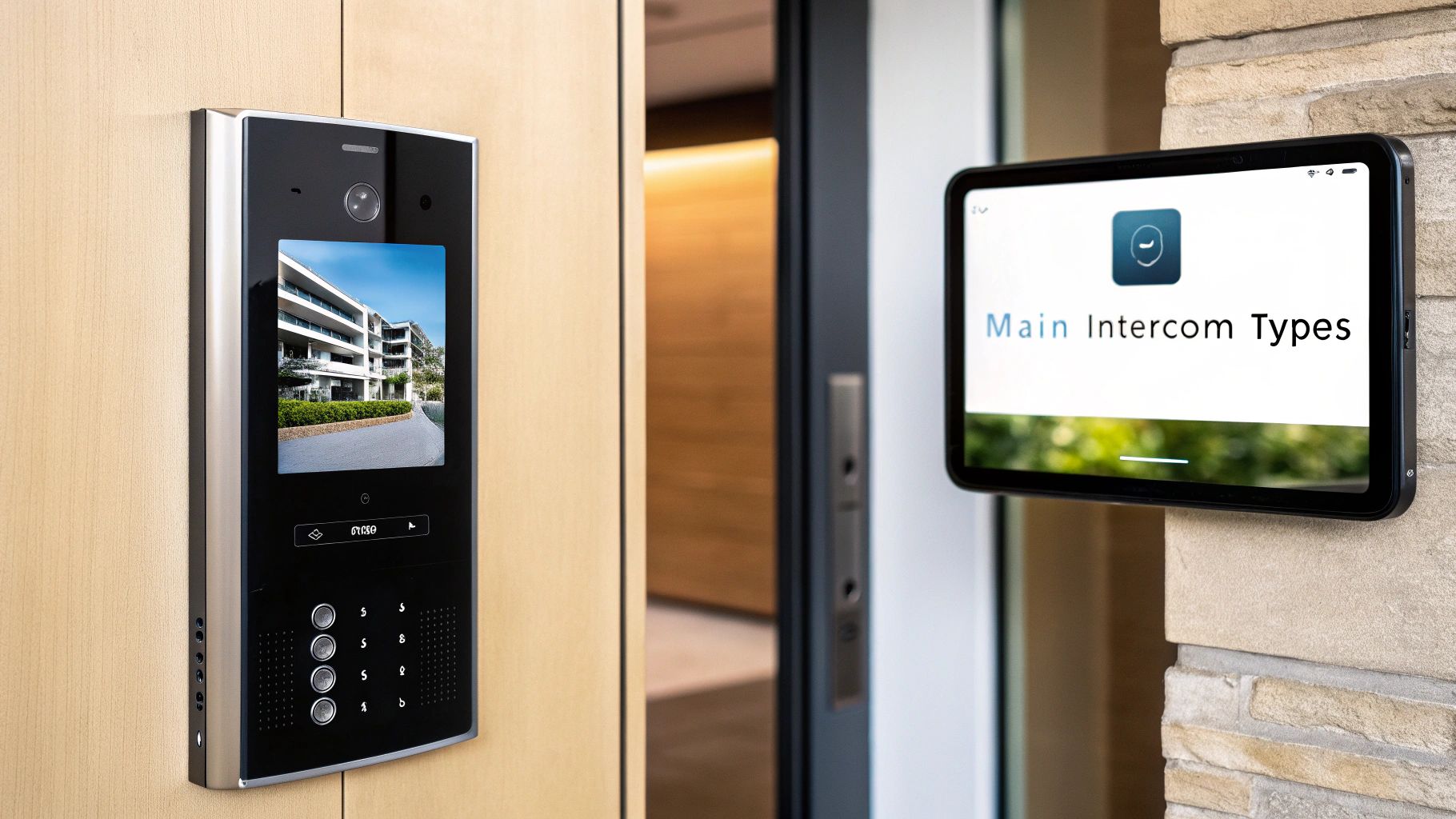
Choosing the right intercom systems for buildings isn't a one-size-fits-all decision. Think of it like buying a vehicle: you wouldn't use a sports car to haul lumber, and you wouldn't take a semi-truck on a quick trip to the grocery store. The right intercom has to fit the job, and that means understanding your property's unique communication and security needs first.
Let's break down the main options, starting with the classic.
Audio-Only Intercoms: The Reliable Standard
Audio intercoms are the workhorses of the industry. They do one thing, and they do it well: provide clear, two-way voice communication. A visitor buzzes the entrance, someone inside answers, they have a quick chat, and a button press unlocks the door. Simple.
Because of their straightforward design, these systems are incredibly reliable and cost-effective. They're a solid choice for smaller apartment buildings or internal office doors where you just need a basic, dependable way to verify who’s asking for entry. They are the foundation upon which everything else was built.
Video Intercoms: Adding Eyes to Your Ears
The biggest leap forward from audio-only is the video intercom. By adding a camera to the outside panel and a screen to the indoor station, you can answer the most important question of all: "Who is really there?"
This isn't just a minor upgrade; it's a fundamental shift in security. Visual confirmation eliminates the guesswork. You can see for yourself if it's the delivery driver you were expecting or a stranger trying to talk their way in. It’s the difference between just hearing a voice and looking someone in the eye before you let them into your space.
A video intercom system transforms access control from a guessing game into a confident decision. The ability to visually verify every guest, delivery person, or service provider is a non-negotiable security feature for many modern properties.
This focus on enhanced security is driving major growth. The global Wired Video Intercom System market, for instance, is projected to climb from $845 million in 2025 to $1,053 million by 2031. These systems provide that crucial real-time audio and visual link, which is why they’re becoming the standard. If you're interested in the data, you can check out the latest market research on wired video intercom systems.
Wired Vs. Wireless Intercoms
Once you decide on audio or video, the next fork in the road is how the system is connected. This is a classic trade-off between rock-solid reliability and installation flexibility.
- Wired Systems: These are the old guard. Physical cables run through the building to connect every component. This hardwired connection is incredibly stable and almost immune to interference, making it the gold standard for performance. The catch? Installation can be a major project, especially when trying to retrofit an older building that wasn't designed for it.
- Wireless Systems: These systems talk to each other using radio frequencies or your building's Wi-Fi network. Their biggest selling point is the ease of installation—no need to drill holes and snake wires through walls. This makes them perfect for historic properties or any situation where invasive construction is a non-starter. The potential downside is susceptibility to signal interference from other devices.
The right choice often comes down to the building itself. If you're building from the ground up, planning for a wired system is easy. For an existing structure, the convenience of a wireless setup might be the smarter play.
IP-Based Intercoms: The Future Is Connected
Welcome to the cutting edge. IP-based intercoms don't need their own dedicated wiring; instead, they plug right into your building's computer network (the LAN) and use the internet to work their magic. This simple change unlocks a whole new world of features that older analog systems just can't touch.
With an IP system, a smartphone or a desktop computer becomes a fully functional intercom station. A property manager can buzz someone in from their office across the complex. A resident can grant access to a friend from halfway across the world.
The advantages are huge:
- Remote Management: Admins can log into a web portal to update tenant directories, create temporary guest passes, or review entry logs from anywhere.
- Mobile App Control: Residents get an app on their phone to see and speak to visitors, then unlock the door with a tap.
- Seamless Scalability: Need to add another station or connect the intercom to your CCTV cameras? On a network, it's a relatively simple task.
- Superior Quality: IP technology can handle high-definition video and crystal-clear audio, providing a much cleaner, more modern user experience.
For large residential communities, corporate campuses, or any property that values modern convenience and streamlined management, IP-based intercom systems for buildings are the clear winner. They create a truly connected and intelligent access experience.
What to Look For: The Must-Have Features in a Modern Intercom System
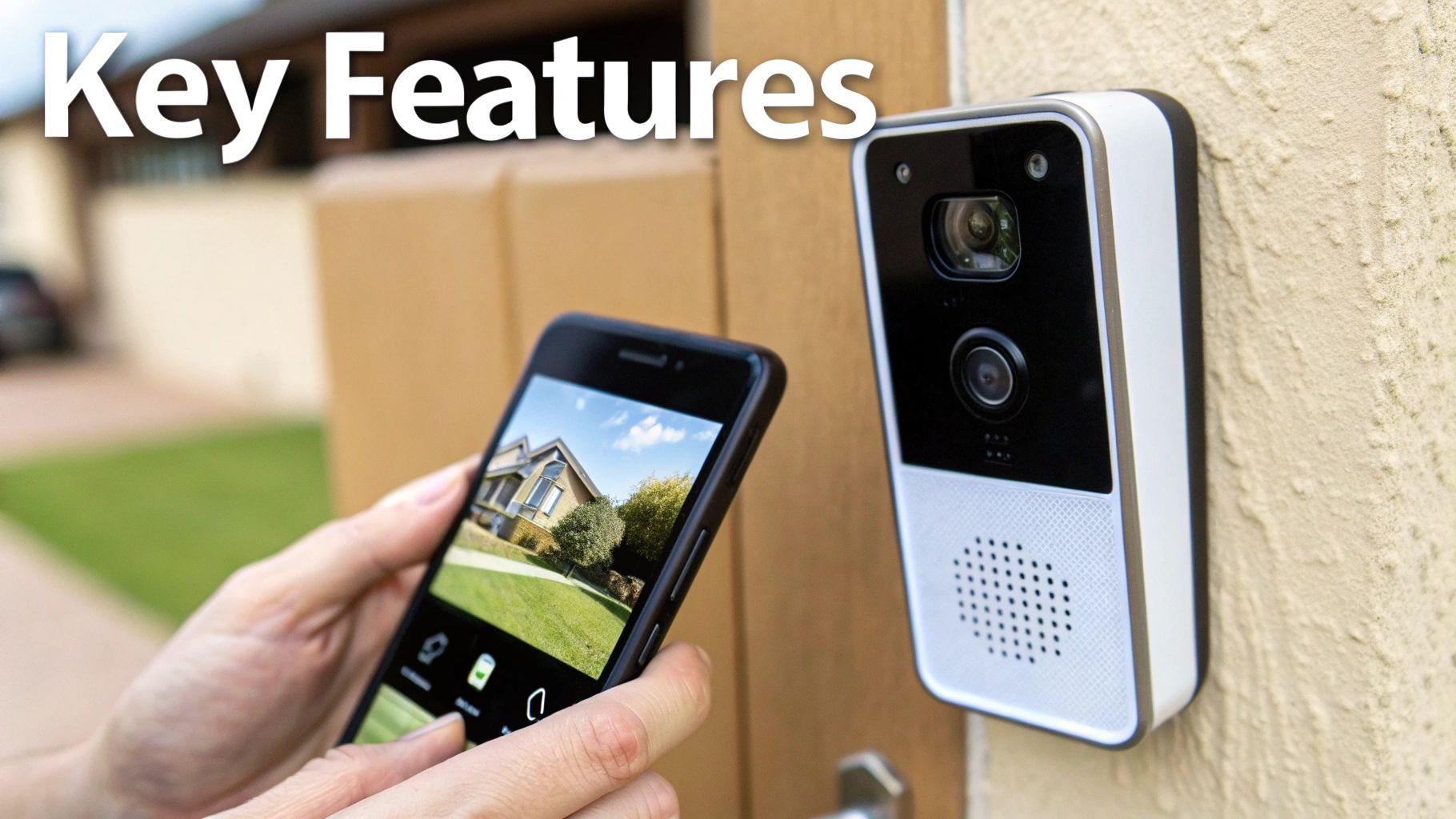
Today’s intercom systems for buildings are a world away from the old-school "buzz-in" box. They've become command centers for security and convenience, fundamentally changing how residents, guests, and managers interact with a property. Knowing which features truly matter will help you make a smart investment.
Think of it this way: a basic intercom is like a flip phone. It does one thing. But a modern system is like a smartphone—it’s a powerful, connected tool that simplifies your life.
Let's break down the features that are no longer optional—they're essential.
High-Definition Video Quality
Forget the grainy, hard-to-see video feeds of the past. High-Definition (HD) video is the new standard, and for good reason. It gives you a crystal-clear, wide-angle view of your entryway so you can identify visitors with absolute certainty, no matter the time of day.
This is more than just a nice picture; it’s a massive security upgrade. With HD video, you can clearly see faces, read an ID badge, or spot unusual activity that a low-resolution camera would completely miss. It's the difference between guessing who's at the door and knowing for sure.
Mobile App Integration and Remote Access
The ability to manage your intercom from anywhere is probably the most powerful feature of a modern system. Mobile app integration effectively turns every tenant's and manager's smartphone into a portable front desk.
This unlocks a whole new level of convenience and control:
- Answer From Anywhere: See and speak with visitors whether you're upstairs, across town, or on vacation.
- Grant Remote Entry: Let in a delivery driver, a friend, or a dog walker with a simple tap on your phone. No more rushing home.
- Get Instant Alerts: Receive notifications for every call or access event, so you always know who is coming and going.
This one feature solves so many common frustrations, from missed packages to getting locked out. It transforms the intercom from a static wall unit into an indispensable tool for modern life.
Cloud-Based Management
For anyone managing a property, cloud-based management is a true game-changer. Forget having to be physically on-site to update a resident directory or change access permissions. Now, you can just log into a secure web portal and handle everything from any computer.
With a cloud-based platform, administrative tasks that once took hours—like adding a new tenant or revoking access for someone who moved out—can be done in minutes from anywhere with an internet connection.
This centralized approach makes operations incredibly efficient, slashes administrative time, and keeps the building’s access directory perfectly up-to-date. It's the end of logistical nightmares for property managers.
Comprehensive Visitor Management Tools
A great intercom does more than just let people talk. Top-tier systems now include powerful features that streamline how you handle visitors, a key component of modern office visitor management systems.
These tools allow residents and staff to create and share temporary, secure access credentials, such as:
- Digital Keys: Send a time-sensitive virtual key to a guest's smartphone that only works during their scheduled visit.
- QR Codes: Generate a unique QR code for one-time access—perfect for contractors, cleaners, or other service providers.
- Delivery PINs: Create dedicated PINs for major couriers so they can securely leave packages inside the building, not on the porch.
These features don't just make life easier for everyone; they also create a detailed digital log of every entry, giving you a clear audit trail and tightening your property’s overall security.
How to Choose the Right Intercom System for Your Building
Picking the right intercom system isn't about finding the single "best" one on the market. It’s about finding the one that perfectly fits your building’s unique needs and personality. Think of it like buying a suit—an off-the-rack option might work, but nothing beats something tailored specifically for you.
Let's walk through a few practical questions to ask yourself. By focusing on these key factors, you can cut through the marketing noise and choose a system that genuinely works for you, your staff, and your tenants for years to come.
Analyze Your Building Type and Size
First things first: what kind of property are we talking about? The ideal intercom systems for buildings look completely different for a ten-unit brownstone versus a massive, multi-building corporate campus. The scale of your property is the biggest factor influencing how simple or complex your system needs to be.
-
Small Residential Buildings (5-50 Units): A straightforward, reliable video intercom with a mobile app usually hits the sweet spot. The main goals here are resident convenience and simple visitor management.
-
Large Residential Complexes (50+ Units): Now you're in a different league. You'll need a powerful, cloud-based system to manage a large directory that changes frequently. Features like temporary delivery PINs and integrations with other building amenities become essential.
-
Commercial Offices: Security and integration are the name of the game. Your intercom absolutely must play well with your existing access control, like key card readers, and provide a clear, detailed audit trail of every entry.
-
Mixed-Use Properties: Flexibility is everything. The system has to serve the different needs of retail shops on the ground floor and the residents living above them, which likely means setting up different access rules and schedules for each group.
Starting with your building's profile immediately helps you narrow down the contenders. Putting a massive IP system in a small apartment building is overkill, but a basic audio-only unit would be a serious liability at a corporate headquarters.
Assess Your Specific Security Requirements
Next, you have to define what "security" really means for your property. Are you just trying to see who’s at the door, or do you need the intercom to be a core component of a much larger security strategy? Your answer here will point you toward the features you should prioritize.
For many properties, a clear video feed and a reliable door release button are perfectly adequate. For others, security is about a much deeper level of control and oversight. This could mean integrating the intercom with your CCTV network, so that ringing the intercom automatically prompts a nearby camera to start recording the interaction.
Your security goals dictate how smart the system needs to be. Basic verification is the starting point, but true security comes from a system that can log events, connect with other platforms, and give you a complete picture of who is coming and going, and when.
This is also the time to think about the future. Do you have plans to add an automated gate for the parking garage or integrate a package room down the line? Choosing a system that’s built to integrate will save you the headache and expense of a full replacement later on.
Balance Your Budget and Long-Term Value
While the upfront price tag is always on your mind, it's critical to consider the total cost of ownership over the long haul. A cheaper system might save you some cash today, but it could cost you more in maintenance fees or need to be replaced much sooner. Modern systems come with different pricing models, from one-time hardware purchases to ongoing software subscriptions.
This is all happening in a booming market. The global wireless intercom systems market is projected to hit $2,469 million by 2025, a clear sign that more and more properties are seeking out these flexible and advanced solutions. You can dive deeper into the full market projections for wireless intercoms to understand the trends.
To make the decision a bit easier, this table breaks down the key considerations based on the type of building you manage.
Intercom Selection Criteria by Building Type
| Building Type | Key Considerations | Recommended System Type | Must-Have Features |
|---|---|---|---|
| Small Apartment Building | Resident convenience, budget-friendliness, simple installation. | Wireless Video Intercom | Mobile app access, high-quality video, remote door release. |
| Large Condominium Complex | Directory management, visitor access, integration with amenities. | Cloud-Based IP Intercom | Cloud management portal, temporary PINs, integration with PMS. |
| Commercial Office Building | High security, integration with access control, audit trails. | IP Video Intercom | Integration with key card systems, detailed event logs, door schedules. |
| Mixed-Use Property | Flexibility, separate access rules for commercial vs. residential. | IP or Hybrid Intercom | Multi-tenant directories, customizable permissions, time-based access. |
| Industrial Facility | Durability, gate control, communication across large areas. | Wireless or Wired IP Intercom | Weatherproof hardware, long-range capabilities, gate control integration. |
Ultimately, using your building's specific profile as a guide will lead you to the most practical and valuable choice.
Integrating Intercoms with Your Building's Technology
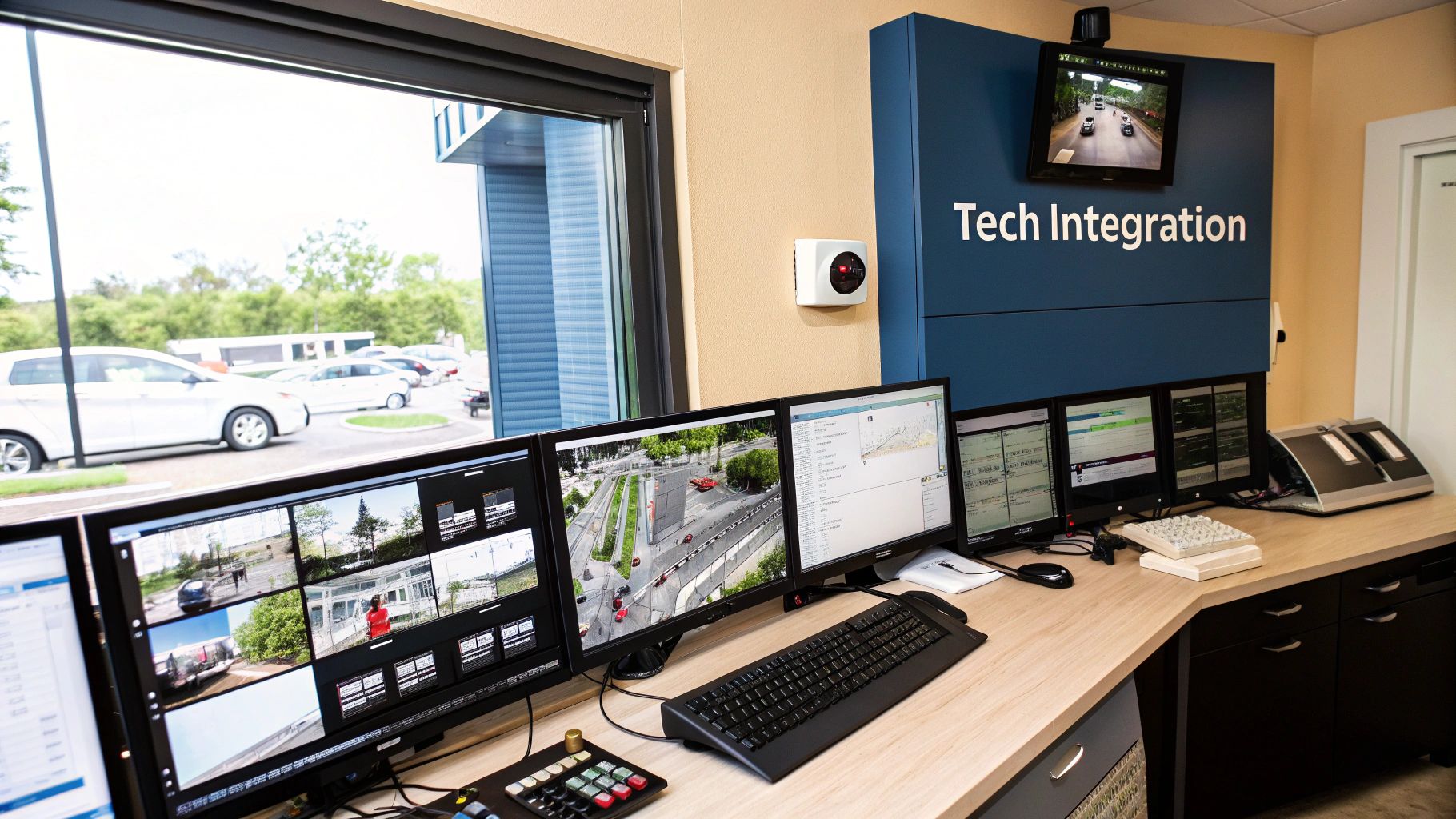
A modern IP-based intercom system doesn't live on an island. It’s a vital piece of your building's larger technology puzzle. Think of it less like a standalone doorbell and more like a central communications hub for your entire security setup. By weaving your intercom into this ecosystem, you transform a collection of separate tools into a single, intelligent security force.
The real magic of today's intercom systems for buildings happens when they start "talking" to other systems. This is where you move from just reacting to entry requests to proactively managing your property’s security in a unified way, creating a seamless flow of information and control.
Unifying Access Control Systems
One of the smartest moves you can make is tying your intercom into your existing Access Control System (ACS). This is the tech that already manages key cards, fobs, and mobile credentials for your tenants and staff. Linking the two creates a single, authoritative platform for every way a person can enter your building.
Imagine this: a visitor calls from the intercom, and a tenant grants them access. That event is instantly logged in the very same system that tracks every key card swipe. This completely streamlines management. Property managers no longer have to bounce between different software to piece together who entered the building and when. Everything is in one place, giving you a crystal-clear audit trail for every door, gate, and entryway. For a deeper dive into securing these points, our guide on gated entry systems has you covered.
Linking with Video Surveillance (CCTV)
Connecting your intercom with your video surveillance network adds a powerful layer of visual proof to every single interaction. This integration turns your security cameras from passive observers into active participants in your access control strategy.
Here’s how that plays out in the real world:
- Event Triggering: A visitor presses the call button. Instantly, the system tells the nearest CCTV camera to pan, tilt, and zoom right onto the entryway.
- Synchronized Recording: The camera starts recording the moment the call begins and stops just after it ends, creating a perfect video clip of the entire event.
- Comprehensive Logs: This video clip is then automatically attached to the entry log, right alongside the time, date, and the resident who granted access.
This creates an ironclad visual record of every visitor. If an incident ever occurs, you don't just have a log entry—you have a time-stamped video of the exact person who was let in.
A standalone intercom tells you that someone was granted access. An integrated intercom shows you exactly who it was, what they looked like, and when they entered, all tied to a single event log.
Planning for Network and Cybersecurity Needs
Bringing an IP intercom system onto your network isn't just a plug-and-play affair. You have to think about your building’s network infrastructure. High-definition video streams, even when compressed, are thirsty for bandwidth. You need to be sure your network can handle the extra traffic without bogging down other critical building operations.
Cybersecurity is just as critical. Any device connected to your network is a potential door for a bad actor. To keep your system locked down:
- Secure the Network: Use strong passwords, encrypt all communications, and—ideally—segment your security devices onto their own virtual network (VLAN) to wall them off from other traffic.
- Regular Updates: Keep your intercom’s firmware and software up to date. This is your first line of defense against the latest security threats.
- Restrict Access: Make sure only authorized personnel have administrative access and require multi-factor authentication to get into any management portals.
By planning ahead for these technical needs, you ensure your integrated system is not only powerful but also rock-solid and secure.
Getting The Installation Right: A Foundation for Success
Even the most sophisticated intercom system for buildings is only as good as its installation. Getting it right from the very beginning is the surest way to guarantee long-term performance and sidestep those frustrating glitches that can plague a poorly planned setup. This isn't just about hooking up wires; it's about smart, strategic execution.
The approach changes dramatically depending on whether you're dealing with a wired or wireless system. For a classic wired setup, the main event is planning the cable runs. You have to be meticulous, making sure the cables are protected from potential damage and shielded from electrical interference.
With wireless systems, the game is different. It's all about the initial site survey. The goal here is to hunt down and map out any potential Wi-Fi dead zones that could drop the signal and kill communication.
Where You Put The Hardware Matters
The physical placement of your intercom units is just as critical as the wiring behind them. You can't just slap a device on the nearest wall and call it a day. Thoughtful placement is what makes the system easy to use, reliable day-in and day-out, and secure for everyone who uses it.
Here are a few pointers from the field:
- Mind the Sun: When positioning an outdoor video intercom, always angle it to avoid direct sunlight. Glare can completely wash out the video feed at certain times of day, making it useless.
- Think Accessibility: Mount all your exterior panels at an ADA-compliant height. This ensures everyone, including visitors in wheelchairs, can easily reach and operate the system.
- Shield from the Elements: If you can, tuck outdoor units under an overhang or awning. This simple step provides a crucial layer of protection against the worst of the weather, from driving rain to heavy snow.
These little details might seem minor, but they have a huge impact on both the daily user experience and how long the equipment will actually last.
For a modern IP-based system, professional installation isn't just a good idea—it's essential. An expert makes sure the system is locked down and securely integrated into your network, shielding it from cyber threats and ensuring it just plain works.
Why You Should Call a Pro
A simple, two-way audio intercom might feel like a weekend DIY project, but today's advanced IP systems are a different beast entirely. They demand professional expertise. A seasoned installer knows the ins and outs of network configuration, security protocols, and how to properly tie the intercom into your building's other security tech.
To get a better sense of what's involved, you can check out our complete guide to commercial security systems installation.
Finally, a truly successful installation doesn't end when the last wire is connected. It wraps up with two crucial, yet often forgotten, steps: user training and planning for maintenance. You need to walk residents and staff through how to actually use the new system. This cuts down on user error and makes sure people can use all the features you paid for.
From there, a simple, proactive maintenance plan—like periodically checking connections, wiping down camera lenses, and keeping software updated—is what will keep your investment running smoothly for years to come.
Got Questions About Building Intercoms? We've Got Answers.
Even with a good grasp of the features and benefits, you probably still have some practical questions about what it really takes to get a modern intercom system up and running in your building. That's completely normal. Let's walk through some of the most common questions we hear from property managers and owners every day.
Think of this as the final checklist before you move forward with confidence.
What's the Real Cost of a Building Intercom System?
This is usually the first question on everyone's mind, and the honest answer is: it varies. The hardware itself can run anywhere from $1,000 to $7,000 per unit, but that's just the starting point. A basic audio-only intercom for a small duplex will naturally be on the low end, while a sophisticated IP video system for a high-rise is going to be at the top of that range.
But the sticker price on the box doesn't tell the whole story. To get a true picture of the total investment, you have to consider a few other key factors:
- Installation Labor: This can be a huge variable. A simple wireless setup in a new construction is a breeze. But retrofitting a wired system into an old building with thick concrete walls? That's a much more labor-intensive job.
- The Wiring Situation: If your building needs new, dedicated wiring run to every single apartment, the cost of both materials and labor will climb quickly.
- Ongoing Subscriptions: Many of the best IP systems today come with a subscription. This usually covers essential services like cloud storage, mobile app functionality, and critical software updates.
Can I Upgrade the Old Intercom System I Already Have?
Absolutely. This is one of the most common projects we tackle. You essentially have two options here: you can retrofit, or you can do a full rip-and-replace.
Retrofitting is often the path of least resistance. The idea is to use the existing wires from your old system to power the new, modern intercom hardware. This can save you a ton of money on labor since you're not tearing open walls to run new cables.
A full replacement is definitely more involved, but it lets you start fresh with a state-of-the-art, IP-based system. It's the best way to get all the latest bells and whistles—like mobile apps and cloud-based management—and really future-proof your building.
How Secure Are Cloud-Based Intercom Systems, Really?
It’s smart to be concerned about security, especially with any device connected to the internet. The good news is that reputable manufacturers take this very seriously and build their intercoms with multiple layers of protection to keep your property, residents, and data safe.
Here's what a secure system should have:
- End-to-End Encryption: This is non-negotiable. It means all the data, from video feeds to audio calls, is scrambled as it travels from the door station to the cloud and then to a resident's phone. To an outsider, it's just unreadable code.
- Regular Security Patches: Good manufacturers are constantly working to stay ahead of new threats. They release regular firmware updates to patch any vulnerabilities, much like the updates you get for your smartphone.
- Secure Admin Access: Access to the system’s backend portal should always be protected with strong passwords and, ideally, multi-factor authentication. This ensures only you or your authorized team can make any changes.
When you choose a quality system and set it up correctly, a cloud-based intercom is an incredibly powerful and secure way to manage who comes and goes.
Ready to bring your building's access control into the modern era with a solution that's reliable, secure, and built for your specific needs? The experts at Clouddle Inc specialize in designing and installing intercom systems that just work. Discover our managed technology solutions today!


